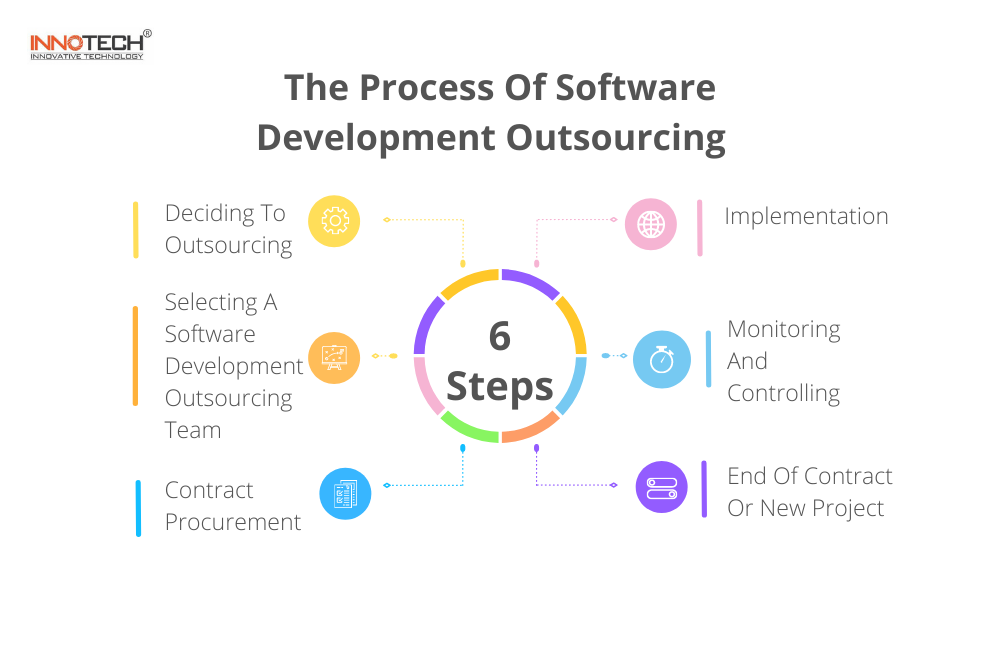Software development outsourcing has such rapid changes today which makes business seems to move more smoothly than ever. The right way to operate software outsourcing can successfully enhance business owners. On the other hand, these changes can also create intense competition among companies.
What Is Software Development Outsourcing?
Software development outsourcing is the process of hiring the skills and expertise from a third party to handle complex tasks relating to software development. By approaching outsourcing services, business owners/entrepreneurs will get the various IT functions to ensure the best outcomes for their clients.
According to a report for the IT outsourcing industry by Statista, it shows that the global outsourcing market amount in 2022 has strongly grown compared to the market size years beforehand. This increasing demand is understandable due to the rapid changing in technology.
Therefore, business owners need to constantly evaluate their systems and adapt to the technology trends for further development. And software outsourcing will be a doorway for organizations to stay updated on these trends by digitizing and optimizing their business processes.

Software Development Outsourcing Models
Now let’s take a look at the outsourcing models in which business owner’s project may be tackled. These models will identify the different ways to utilize software outsourcing based on the relationship between the clients and the vendor. Below are three primary models.
Staff Augmentation
In this software development outsourcing scenario, the business owner brand will delegate the task of building a remote outsourcing team to the outsourced provider. Although the provider will complete the project and handle the day-to-day running of the team, the client will retain control over hiring, firing, team building, and distribution responsibilities.
Dedicated Team
This model is fairly simple. The software development outsourcing provider will put together a team dedicated to the company’s project which will usually remain the same for current and future projects. In this instance, the provider will generally retain control of all aspects of running the team.
Project-Based
It’s probably the most popular kind of contract for software outsourcing. In the project-based model, you can brief the software team working on the project and then, to a large extent, leave them to it. This means that the developers will make all the decisions relating to the software project themselves and will simply send reports on the progress made.
See more about 3 types of software development outsourcing.
The Process Of Software Development Outsourcing
Having covered the definition of outsourcing and discussed different model options available for businesses, now let’s delve a little deeper for those wondering how to go about it.

Step 1 – Deciding To Outsource
At first, this important first step should never be overlooked. This stage requires companies to examine the reasons for outsourcing. Therefore, they may perform a cost and skill analysis in order to figure out if outsourcing software development is the right choice for their project.
In this way, companies need to create a checklist in order to compare the various aspects involved in terms of hiring a member of staff or outsourcing the project.
Step 2 – Selecting A Software Development Outsourcing Team
This is an extremely important step and one which will become the central hub of their software development outsourcing project. For this reason, it’s crucial to dedicate a substantial amount of time and energy to this stage.
Accordingly, the business owner’s first task is to decide on the location of their new outsourcing team. Next, they’ll need to compile a list of relevant software outsourcing companies in the chosen country. Seeking recommendations from other businesses, and taking a look at rankings or forums will help companies to whittle down what may be a rather long list!
-
Request for information and proposal
Subsequently, once they have the shortlist of potential suppliers, the next step should be to send a request for information (RFI) or a request for proposal (RFP) to each software development outsourcing company. These are, essentially, documents that outline the parameters of your software project and invite suppliers to send you a proposal including a price quote for the work.
These RFI or RFP should include:
- Software project overview
- Your company’s background and history
- The goals of your software project
- The project’s scope
- Initial target deliverable schedule
- Possible roadblocks
- Budget constraints
- Expectations from the outsourcing company
Learn more about HOW MUCH DOES SOFTWARE DEVELOPMENT OUTSOURCING IN VIETNAM COST?
-
Trial with a test project
Afterward, companies will want to see what they can do. At this stage, they will be asking the suppliers to provide details of previous projects which are similar to theirs. From here, they can visit websites and apps in order to see how well these previous projects function. The shortlist will be cut down then.
Now that companies have a manageable shortlist of software development outsourcing suppliers, they may want to task the outsourcing team with a test project before making a final decision. This will help analyze each outsourcing team in terms of communication, reliability, time management, and, most importantly, abilities.
Step 3 – Contract Procurement
Before embarking on any software development outsourcing project with a supplier, it’s of paramount importance to have a proper, legally binding contract. Not only does this reinforce the agreed details of the project but it will protect both parties in the event of any issues.
Step 4 – Implementation
Now business owners are ready to start their software development outsourcing project. But it’s haven’t been timing to sit back and let the team get on with it yet. First, there are a couple of things to think about to help make sure that the project succeeds:
- Risk Management Strategy
Addressing anything that might go wrong during the software development outsourcing project, such as employee absenteeism or market fluctuations. It’s essential that companies have a risk management strategy in place so that they’re ready to deal with any speed bumps along the way as your project progresses.
- The Software Development Cycle
Next, speaking to the process of the project which will involve information gathering, system design, requirements analysis, coding, quality control, and testing. In most cases, their software development outsourcing team will already be familiar with this.
-
Testing
Finally, the software development outsourcing team should be testing the product at every stage and sharing results with the business owner. It’s important to make sure that the supplier is documenting each testing stage, listing the successes and failures and the reasons behind them as well as plans for improvement.
Step 5– Monitoring And Controlling
Although business owners may not physically be doing the work themself, they still hold responsibility for its success. For the savvy business, this means putting into place a proper monitoring system to make sure that everything is going accordingly to plan. They might be looking at a number of factors, including:
- Time management – is the team putting in the agreed hours and, at the agreed times (this may be important if there is a time zone discrepancy).
- Honesty – are they being billed for hours not worked (or hours during which employees were surfing the net or engaging in activities unrelated to their project)?
- Productivity – is the project progressing according to the timeline agreed upon?
- Reporting – are they up to date with all aspects of the project’s progress?
Step 6 – End Of Contract Or New Project
With good quality software development outsourcing companies, it is quite often the case that contracts are extended or renewed to cover other projects or services (e.g., support and maintenance).
Afterward, once a decision to terminate a contract has been made, it is time to see how the exit strategies the business owner included in the contract, together with transition plans and arrangements for transfer files are working.
Conclusion
In summary, this article has been presented to give general information relating to software development outsourcing services. The guide above on how to work with a partner will help business owners/entrepreneurs to make an informed choice of the outsourcing company that fits their requirements and expectations.
With 14+ years of experience, 200+ projects done, and a team full of talented individuals, Innotech Vietnam can be a reliable partner if you are looking for a software development outsourcing vendor.
Contact our team of experts if you have any queries or concerns about offshore software development and we’ll be more than pleased to assist you.


